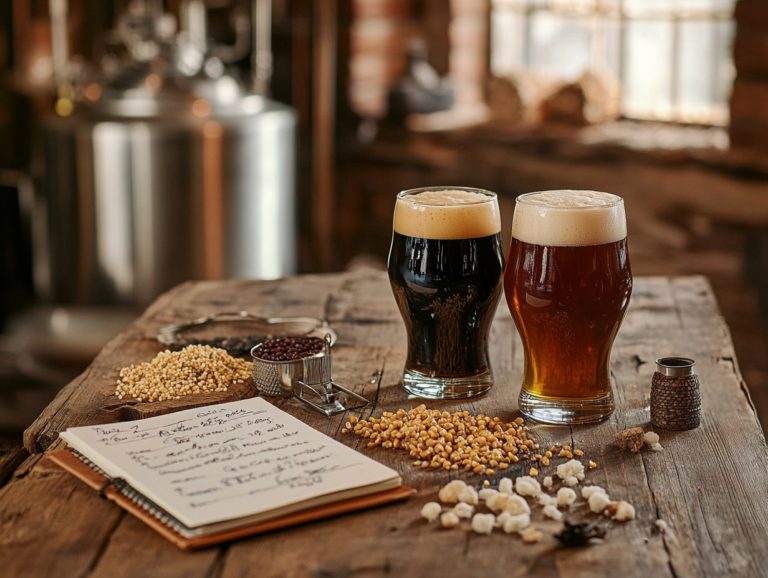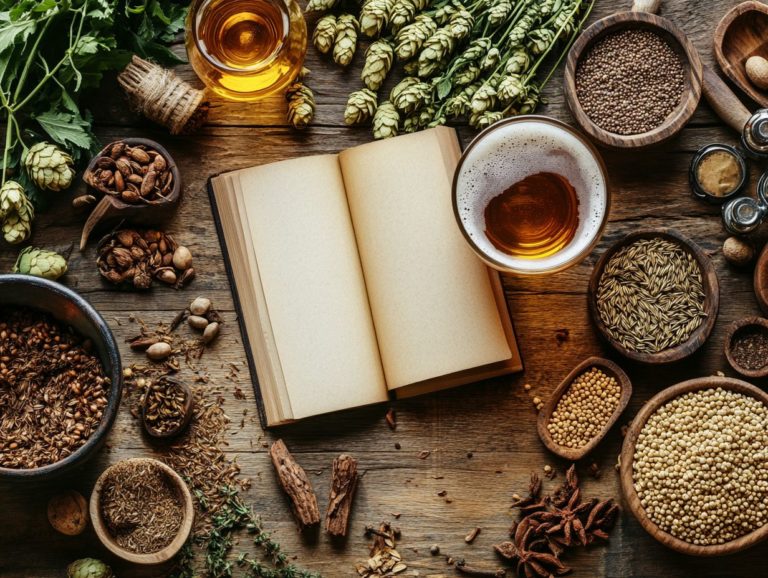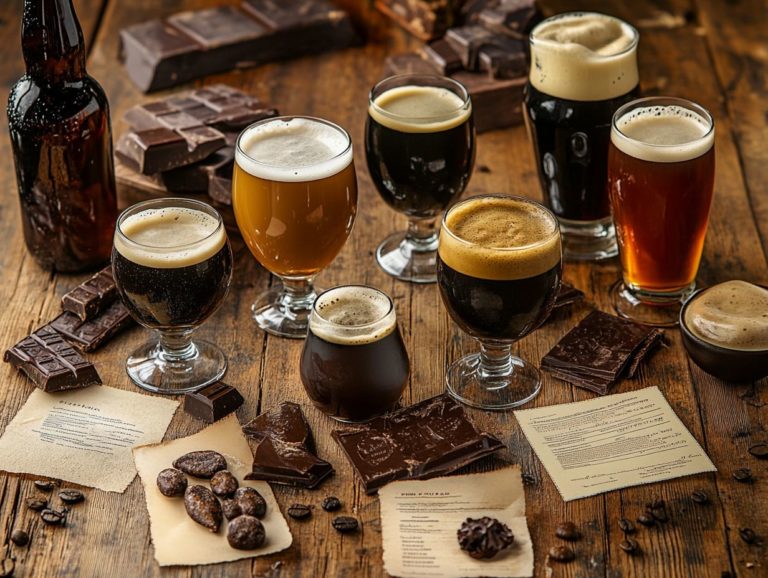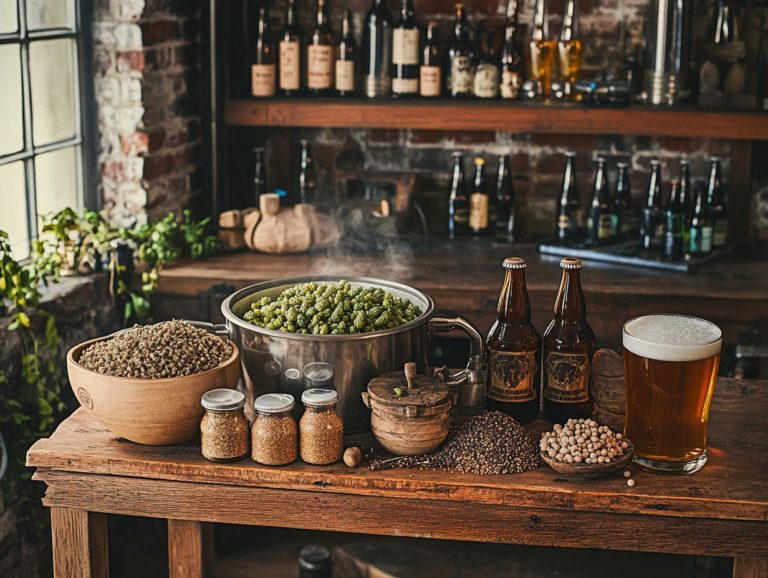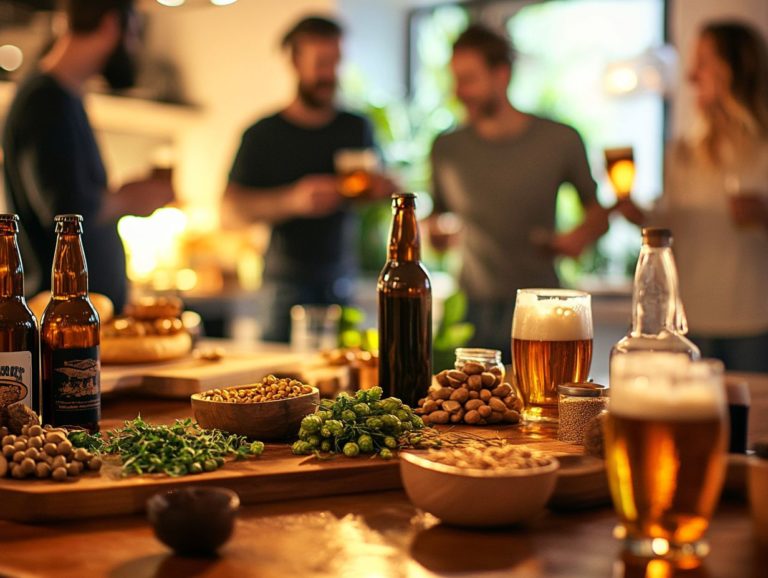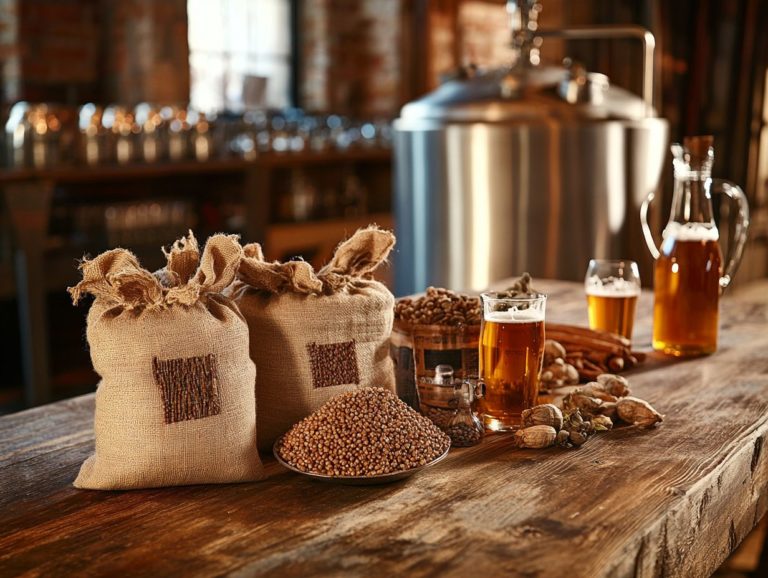How to Brew an Herbal Infused Beer
Brewing herbal-infused beer offers unique flavors and health benefits, transforming a classic beverage into a delightful concoction that delights the senses. This exciting adventure merges traditional beer brewing with the creativity of herbal tea infusions.
Whether you are a seasoned homebrewer or just beginning your brewing journey, incorporating herbs like chamomile, ginger, or lavender can elevate your brew to extraordinary heights. Consider experimenting with ancient brewing styles, such as gruit recipes, to craft unique herbal ales.
Get ready to explore the exciting world of herbal beer brewing! This guide will walk you through the benefits, essential steps to create your own herbal masterpiece, popular herbs to experiment with, and invaluable tips for a successful brewing experience. You ll also discover how to integrate these herbs into your existing beer recipes and explore alternative hops options.
Unleash your creativity and discover how to craft your signature herbal beer, impressing your friends with your newfound skills and imaginative brewing flair!
Contents
- Key Takeaways:
- Why Should You Brew Herbal Infused Beer?
- What Are the Basic Steps to Brew Herbal Infused Beer?
- Which Popular Herbs Enhance Herbal-Infused Beer?
- What Are Some Tips for Brewing a Successful Herbal Infused Beer?
- Frequently Asked Questions
- What is herbal infused beer and how is it different from regular beer?
- What are some common herbs used in herbal infused beer?
- Can I use fresh herbs in my herbal infused beer?
- How do I add herbs to my beer during the brewing process?
- Can I use any type of beer to brew an herbal infused beer?
- Are there any safety precautions I should take when brewing herbal infused beer?
Key Takeaways:
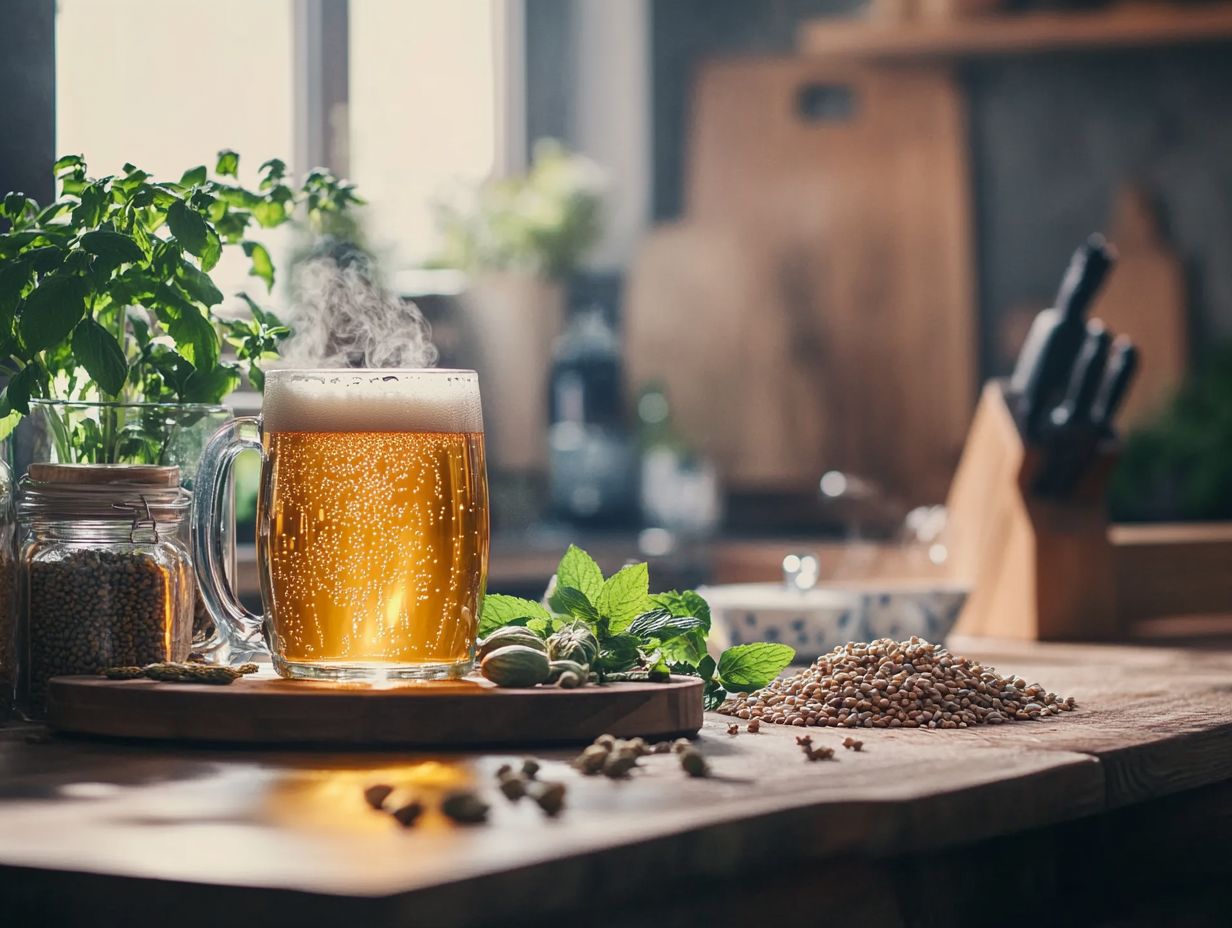
- Discover the benefits of brewing herbal-infused beer, such as added flavor and potential health benefits.
- Follow the basic steps of choosing, preparing, and adding herbs to your beer to create a unique and flavorful brew.
- Popular herbs for herbal-infused beer include hops, chamomile, ginger, lavender, basil, and rosemary. Experiment with different combinations for unique flavors. For even more variety, consider brewing with herbs like sarsaparilla, licorice root, and nettle leaf.
- For a successful brew, use fresh herbs and a good quality base beer. Avoid overdoing it with the herbs, and be patient let the beer age for optimal flavor.
Why Should You Brew Herbal Infused Beer?
Brewing herbal-infused beer not only connects you with centuries of brewing heritage but also introduces you to a broader community of craft brewing enthusiasts.
Brewing herbal-infused beer presents a remarkable experience that merges creativity with time-honored traditions, greatly enhancing your brewing journey. By integrating herbal ingredients, you can create distinctive flavor profiles that tantalize your taste buds and link you to centuries of brewing heritage. Learn about the herbs and spices that have been used in beer making and the benefits they bring to your brewing adventure.
This process allows you to delve into the intricate world of herbal fermentation. You can draw on a variety of organic herbs such as fresh oregano, ginger root, and dandelion root to craft complex and delightful beverages. The addition of herbal tea blends can further diversify your beer styles and enhance your brewing repertoire.
Whether you’re a seasoned brewer or just starting out in homebrewing, the realm of herbal beer opens a world of possibilities for designing your personal signature beer styles. Engage with community brewing events and brew schools to enhance your knowledge and skills. For deeper insights into herbal beer culture, explore the Sacred & Herbal Healing Beers by Stephen Harrod Buhner.
What Are the Benefits of Herbal Infused Beer?
Exploring the benefits of herbal ales can be both enriching and enlightening, offering distinct advantages over traditional brews.
Herbal infused beer does more than just elevate the flavor profile of traditional brews; it offers you a wealth of health benefits and unique experiences that every craft beer enthusiast will appreciate. By infusing herbal ingredients, brewers craft distinct tastes that invigorate your senses and connect you with nature in every sip.
For example, when you enjoy a beer with chamomile a floral herb celebrated for its calming properties you might discover soothing flavors that envelop you in a comforting experience. Similarly, beers infused with rosemary can introduce a delightful pine-like aroma, perfectly complementing the maltiness and creating a refreshing yet complex brew. The use of basil and mint can add sweet and refreshing notes, enhancing the overall sensory experience.
Herbs like ginger and eucalyptus not only enhance the flavor, but they also provide digestive aids or respiratory support, respectively. These combinations open the door to captivating taste-testing adventures, allowing you to explore a spectrum of flavors while potentially reaping the wellness benefits associated with each herb.
Savoring herbal infused beer is more than just enjoying a drink; it s an exploration of unique ingredients that tantalize your palate and promote a holistic sense of enjoyment. Engaging in taste testing with friends can further enrich your appreciation for these unique flavor profiles.
What Are the Basic Steps to Brew Herbal Infused Beer?
Brewing herbal-infused beer is an art form that involves a series of essential steps, transforming simple ingredients into a flavorful craft masterpiece. It all begins with wort preparation, where you select high-quality ingredients and thoughtfully incorporate herbal elements to elevate the beer’s unique flavor profile. This step is crucial in setting the stage for the fermentation process, and ultimately, the successful creation of your herbal beer.
Next comes the fermentation process, a critical phase that shapes the final character of your brew. This stage demands your attention to detail to achieve that perfect taste and aroma. Drawing on fermentation methods used in both ancient and modern beer brewing can yield exciting and diverse results.
For those just starting out, grasping these foundational steps can greatly enrich your brewing experience, deepening your appreciation for the craft and the delightful journey of creating your own beer.
Step 1: Choose Your Herbs
Choosing the right herbs is the essential first step in brewing herbal infused beer, as it profoundly impacts the flavor and aroma of your final creation. Consulting an ingredients list with various herbs and spices can help you determine the best combinations for your beer recipe.
When selecting herbs, you should carefully consider their flavor profiles, potential health benefits, and how effectively they can complement or even replace traditional hops. For example, fresh oregano brings a savory note that adds depth to your brew, while basil introduces a sweet and aromatic character. Herbs like chamomile not only provide soothing properties but also contribute a floral essence that enhances the complexity of your beer.
Consider popular pairings such as rosemary and thyme, which can craft a robust flavor profile, or opt for lighter herbs like mint or lemongrass to infuse refreshing undertones. By thoughtfully combining these herbs, you can create a unique herbal beer recipe that not only delights the palate but also offers distinct health advantages.
Step 2: Prepare Your Equipment
Preparing your equipment is an important step in the brewing process, ensuring that all your tools are sanitized and ready for action. A well-organized home brewing kit, complete with fermentation vessels, yeast starters, and measuring tools, is essential for achieving a successful herbal beer brew. Consider enrolling in a brew school or following BJCP guidelines to deepen your understanding and enhance your brewing experience.
The equipment you choose can significantly influence the flavor and quality of your final product. If you re just starting out, investing in a basic kit that includes a primary fermenter, airlock, and bottling wand can simplify your initial efforts. On the other hand, if you re more experienced, you might prefer advanced fermentation systems that offer precise temperature control and monitoring.
Always prioritize sanitation by using food-grade cleaning solutions. Thorough cleaning is your best defense against unwanted bacteria that can spoil your brew. With the right setup, you not only streamline the brewing process but also enhance your ability to experiment with a variety of herbs and flavors, leading to unique and delightful concoctions.
Step 3: Prepare the Wort
The wort preparation stage is where the magic truly begins, forming the essential base for your herbal beer. This process calls for you to select and boil the right grains and malt extracts, creating a rich and flavorful wort (the liquid extracted from the mash during the brewing process) that serves as your canvas for herbal infusion.
Choosing the right grains is crucial; they contribute both the sugars necessary for fermentation and the distinct flavors that will define your beer. Typically, you’ll want to use a combination of base malts and specialty malts to achieve a well-rounded profile. The selection of these beer ingredients plays a vital role in the overall quality and taste of your final product.
During the boiling phase, temperature control and timing become your best allies in extracting the essential sugars and flavors from the grains, ensuring the desired sweetness and body. The interaction between the wort and the herbal ingredients you add later can significantly elevate the complexity of the final product, allowing the unique characteristics of the herbs to harmonize beautifully with the malt foundation. Following this, the careful preparation of the wort sets the stage for the fermentation process, leading to rich and aromatic results.
This careful craftsmanship will lead to a beverage that is not only aromatic but also rich in taste and mouthfeel.
Step 4: Add the Herbs

Adding the herbs is an important moment in your journey of brewing herbal-infused beer, as this is when your chosen flavors meld into the wort. The timing and techniques you employ for the herbal infusion can dramatically influence the flavor profile, making it essential to grasp the best methods for incorporating your selected herbs. This step is where your creativity can truly shine!
For instance, you ll want to add delicate herbs, like chamomile or lavender, towards the end of the boil to preserve their aromatic qualities. On the other hand, sturdier herbs such as sage or thyme can thrive with an earlier addition, allowing their robust flavors to fully develop.
Don’t shy away from experimenting with steeping times; a quick infusion may impart a subtle hint of flavor, while a longer brew can extract more pronounced herbal notes. Successful recipes often strike a balance between these intensities think of a pale ale infused with coriander for a zesty brightness or a stout enriched with rosemary for added depth.
By mastering the timing and technique, you can seamlessly integrate herbs into your brewing process, elevating your beer recipes to new heights. This mastery is supported by resources from experts like David Ackley and institutions such as the Siebel Institute and the New England Academy of Herbal Medicine.
Don t wait too long start experimenting with your herbal blends today!
Step 5: Ferment and Bottle the Beer
The fermentation and bottling phase is where your herbal-infused beer undergoes an enchanting transformation, turning your meticulous preparations into a delightful finished product. This stage demands both patience and careful attention, as the fermentation process directly influences the final flavor and carbonation of your brew. Utilizing advanced fermentation systems or adhering to specific fermentation methods can further refine your brewing skills.
During fermentation, yeast takes center stage, converting the sugars from the wort and herbs into alcohol and carbon dioxide. Watch as this magical reaction transforms your ingredients into delicious beer in a perfect brewing environment! The ideal temperature ranges from 65 F to 75 F (18 C to 24 C) for ales, allowing the yeast to flourish and impart distinct flavors. Using a yeast starter like Wyeast 1056 can help ensure a robust and healthy fermentation process.
The fermentation duration can vary quite a bit, typically lasting anywhere from a week to several weeks, depending on your specific recipe and the yeast strain you ve chosen.
Once fermentation wraps up, employing proper bottling techniques becomes essential. Ensuring your bottles are well-sanitized and filled correctly is key to preventing contamination and achieving controlled carbonation.
After you ve bottled your masterpiece, be sure to give it some time to age your future taste buds will thank you! Aging for a few weeks can significantly enhance complexity and smooth out any harsh flavors, resulting in a more refined final product that you ll be proud to share.
Which Popular Herbs Enhance Herbal-Infused Beer?
Herbal-infused beer presents an exciting opportunity to explore a wide array of popular herbs, each adding its own unique flavors and aromas that elevate the drinking experience. Imagine the balance of the classic bitterness of hops complemented by the calming notes of chamomile.
The selection of herbal ingredients enables brewers to create distinctive profiles that cater to a diverse range of palates, ensuring there s something delightful for everyone.
1. Hops
Hops are the cornerstone of your brewing journey, offering essential bitterness and a variety of complex flavor profiles that define many beer styles. They can smell and taste floral or citrusy, transforming them into an incredibly versatile herb in the brewing process.
As you brew, selecting specific hop varieties allows you to achieve desired effects that can vary dramatically based on their origin and the techniques you employ. Hops also serve as preservatives and may have health benefits. When you combine them with other herbal ingredients, the resulting interactions can create unique nuances in flavor, elevating the overall tasting experience.
Striking the right balance in your brew demands careful adjustment of hop levels to manage both bitterness and aroma, especially in styles like IPAs and pale ales. This meticulous balance ensures that your final beer is not only refreshing but also multidimensional, inviting a deeper appreciation from those fortunate enough to savor it.
2. Chamomile
Chamomile stands out as a delightful herb, celebrated for its soothing properties and floral notes, making it an exceptional choice for herbal beer brewing. Its gentle flavor profile elevates the drinking experience, particularly when paired with other harmonious herbs.
As you sip, the subtle sweetness of chamomile emerges, beautifully mingling with spices like ginger or the zesty brightness of orange peel, crafting a refreshing complexity that enhances your palate. This cherished herb offers a plethora of health benefits, including calming effects that promote relaxation and support digestion.
In your brewing adventures, consider using chamomile in lighter beer styles, such as wheat beers and saisons, where it imparts a delicate aroma that captivates the senses. A prime example of successful incorporation is a chamomile-infused pale ale, where the floral notes dance alongside the hop bitterness, resulting in a well-rounded and thoroughly enjoyable beverage.
Some brewers even delve into the realm of herbal stouts, utilizing chamomile to add depth and an inviting aromatic layer to the rich character of dark malts.
3. Ginger
Ginger brings a spicy kick to herbal-infused beer, adding warmth and zest that can truly elevate the drink’s flavor. Its unique qualities make it a versatile ingredient in both traditional and modern brewing recipes.
Beyond its bold flavor, ginger is celebrated for its many health benefits, such as aiding digestion and helping reduce swelling and pain. When thoughtfully incorporated into beer recipes, it creates a delightful balance, harmonizing with other herbs and spices while introducing a refreshing sharpness.
If you’re considering brewing your own ginger-infused beer, it’s crucial to understand how to best harness its flavor. Freshly grated ginger can deliver a more intense experience, while dried ginger tends to provide a milder profile. By adding ginger at different stages of the brewing process, you can achieve varying levels of intensity. Experimentation is essential to uncovering your perfect taste.
4. Lavender
Lavender introduces a distinct floral aroma and flavor to herbal-infused beer, crafting a unique sensory experience that will captivate your palate. Its calming properties have made it a beloved herb among both herbalists and brewers.
When incorporated thoughtfully, lavender can enhance the overall character of your brew, adding a touch of elegance that beautifully complements vinegar notes and light citrus flavors. The subtle sweetness of lavender works in perfect harmony with other herbs like chamomile and mint, enriching their complex profiles while maintaining a delicate balance.
Achieving the right intensity is essential; too much lavender can easily overshadow the beer’s foundational flavors. As a rule of thumb, begin with a small amount perhaps a teaspoon of dried flowers and adjust gradually according to your taste tests at various stages of brewing. This approach will guide you toward a perfectly harmonious blend.
5. Rosemary
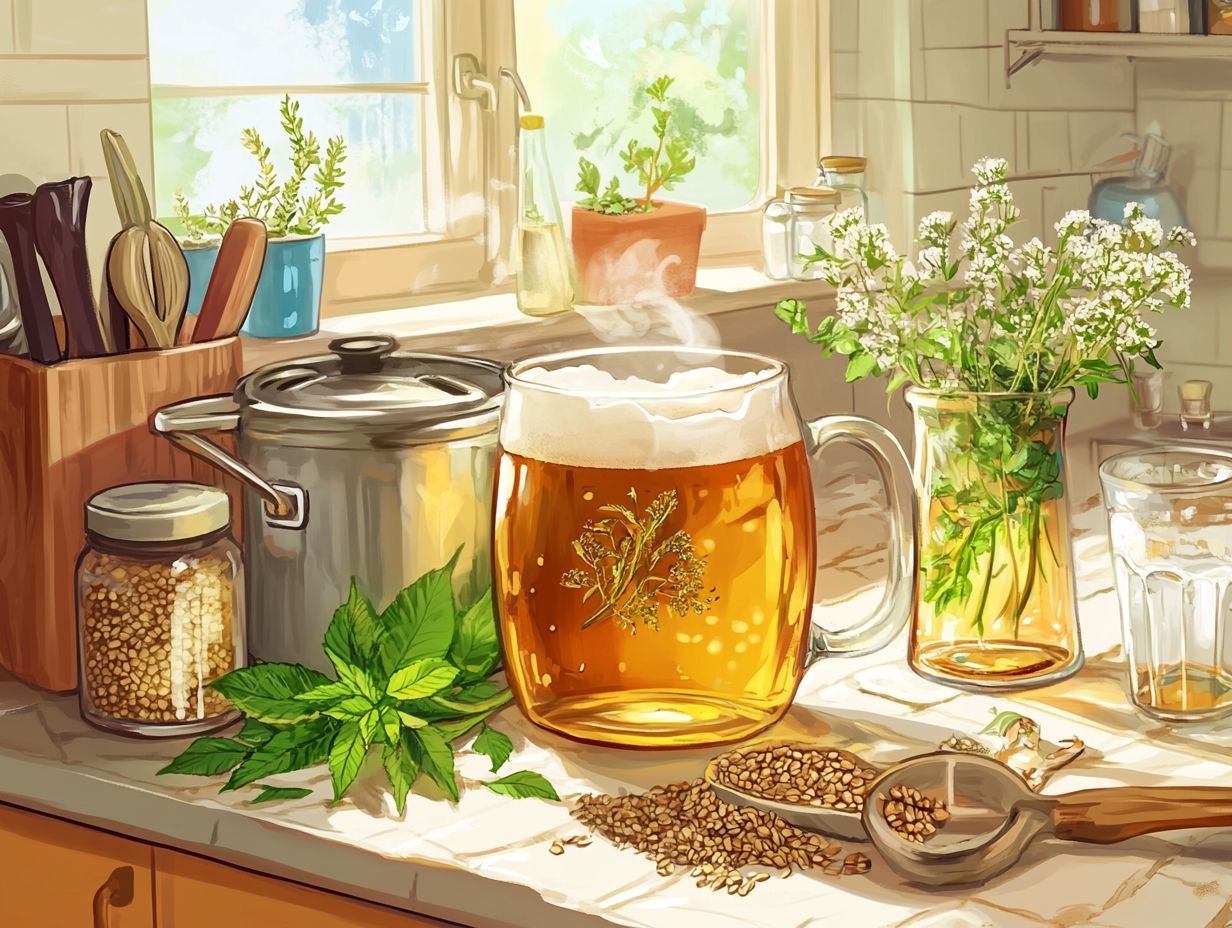
Rosemary is an aromatic herb that brings a robust flavor and delightful aroma to herbal-infused beer, making it a go-to choice among craft brewers. Its powerful profile can beautifully complement various styles, adding depth and character to your brew.
When you incorporate rosemary into your herbal beers, it introduces a unique blend of earthy, pine-like notes that can elevate your tasting experience. This herb not only enhances the complexity of flavors but also offers potential health benefits, including antioxidants.
It also pairs exceptionally well with styles like pale ales and IPAs, where its floral undertones can expertly balance the bitterness of hops. Stouts and porters can also benefit from rosemary’s herbal qualities, creating a more nuanced flavor profile that intrigues the palate.
Beer lovers rave about brews infused with rosemary! These creations are often celebrated for their refreshing qualities, making them an enticing choice for craft beer enthusiasts eager to explore innovative combinations.
What Are Some Tips for Brewing a Successful Herbal Infused Beer?
- Utilize fresh herbs to maximize flavor and aroma.
- Explore an array of flavor combinations that will tantalize the palate.
- Have patience; allow yourself the necessary time during both the brewing and aging processes to achieve the perfect herbal beer recipe.
- Embrace these principles to create a truly exceptional beverage that showcases your craftsmanship.
1. Use Fresh Herbs
Using fresh herbs in your brewing process is essential for maximizing the flavor and aroma of your herbal-infused beer. Fresh herbs are packed with essential oils and compounds that elevate the overall experience, infusing vibrant depth into your brew.
Unlike dried herbs, which may have lost some of their aromatic properties during the drying process, fresh herbs maintain a potent impact that can significantly enhance the character of your beer. To ensure you capture the freshest flavors, consider sourcing herbs from local markets or even growing them at home for immediate use.
When handling fresh herbs, remember to gently wash them to remove any dirt. Chop or bruise the leaves before adding them to your brew. This technique releases the oils and aromas, resulting in a more pronounced and enjoyable tasting profile in the finished product.
2. Experiment with Different Combinations
Experimenting with different combinations of herbs is an exhilarating facet of brewing herbal-infused beer. This creative journey encourages exploration and innovation, resulting in distinctive flavor profiles that surprise and delight the palate.
Inviting others to experiment with various herbal mixes opens the door to a world of possibilities and aids in achieving a harmonious balance of flavors. This enriches the overall drinking experience. By playing with complementary and contrasting notes, you can uncover unexpected pairings that elevate your brewing prowess.
Sharing insights on balancing sweet, bitter, and aromatic qualities enables both novice and seasoned brewers. As your creativity flourishes throughout the brewing process, you may find yourself venturing into uncharted territory, potentially leading to the creation of entirely new beer styles that tantalize taste buds and spark engaging conversations.
3. Use a Good Quality Base Beer
Selecting a high-quality base beer is essential for a successful herbal infusion. It serves as the foundation for the distinctive flavors you want to create. The quality of this base beer significantly impacts the overall flavor profile and the interaction of herbs throughout the brewing process.
A meticulously crafted base beer adds layers of depth and enhances the herbal elements, allowing them to shine without overwhelming the palate. For herbal infusions, styles like wheat beers or pale ales make excellent choices, as their light and refreshing nature supports delicate flavors rather than concealing them. A smooth brown ale can provide a rich backdrop, perfectly suited for herbs with earthy undertones.
A light lager introduces a crispness that beautifully complements fresh, aromatic herbs, resulting in a balanced and delightful experience for your taste buds.
4. Don’t Overdo It with the Herbs
Striking the right balance when using herbs in your brewing process is crucial to avoid overpowering the flavor of your beer. While herbs can enhance both aroma and taste, moderation is key to achieving a harmonious profile in your herbal-infused brew.
To find the perfect amount of herbs, start with a small infusion and gradually increase the quantity, tasting at various stages along the way. This approach allows you to monitor each herb’s interaction with the existing flavors of your beer. For more detailed guidance, check out this how to brew beer with spices and herbs recipe.
Be mindful of common pitfalls, such as using dried herbs that are past their prime or overlooking the drying method. These can lead to bitterness or a loss of aromatic qualities. By continuously sampling throughout the brewing process, you can adjust the flavor components to attain the desired balance, resulting in a more enjoyable and well-rounded final product.
5. Be Patient and Let the Beer Age
Patience is your secret weapon in brewing, especially when allowing your herbal-infused beer to age gracefully. Don t rush! Giving your beer the time it needs to mature can significantly enhance its flavor profile, ensuring that the herbal notes meld seamlessly with the base.
The aging process is essential as it allows those complex flavors to harmonize, resulting in a richer and more satisfying drinking experience. Different styles of herbal beer benefit from varying aging periods; for instance, light herbal beers typically require just a month to six weeks, while the heavier, maltier varieties truly shine after three to six months.
If you’re feeling adventurous and want to experiment with stronger herbs or botanicals, extending the aging process up to a year can reveal surprising depth and intricacies in flavor. Embracing patience in this craft rewards you as a brewer and creates an unforgettable experience for those lucky enough to enjoy your final product.
Frequently Asked Questions
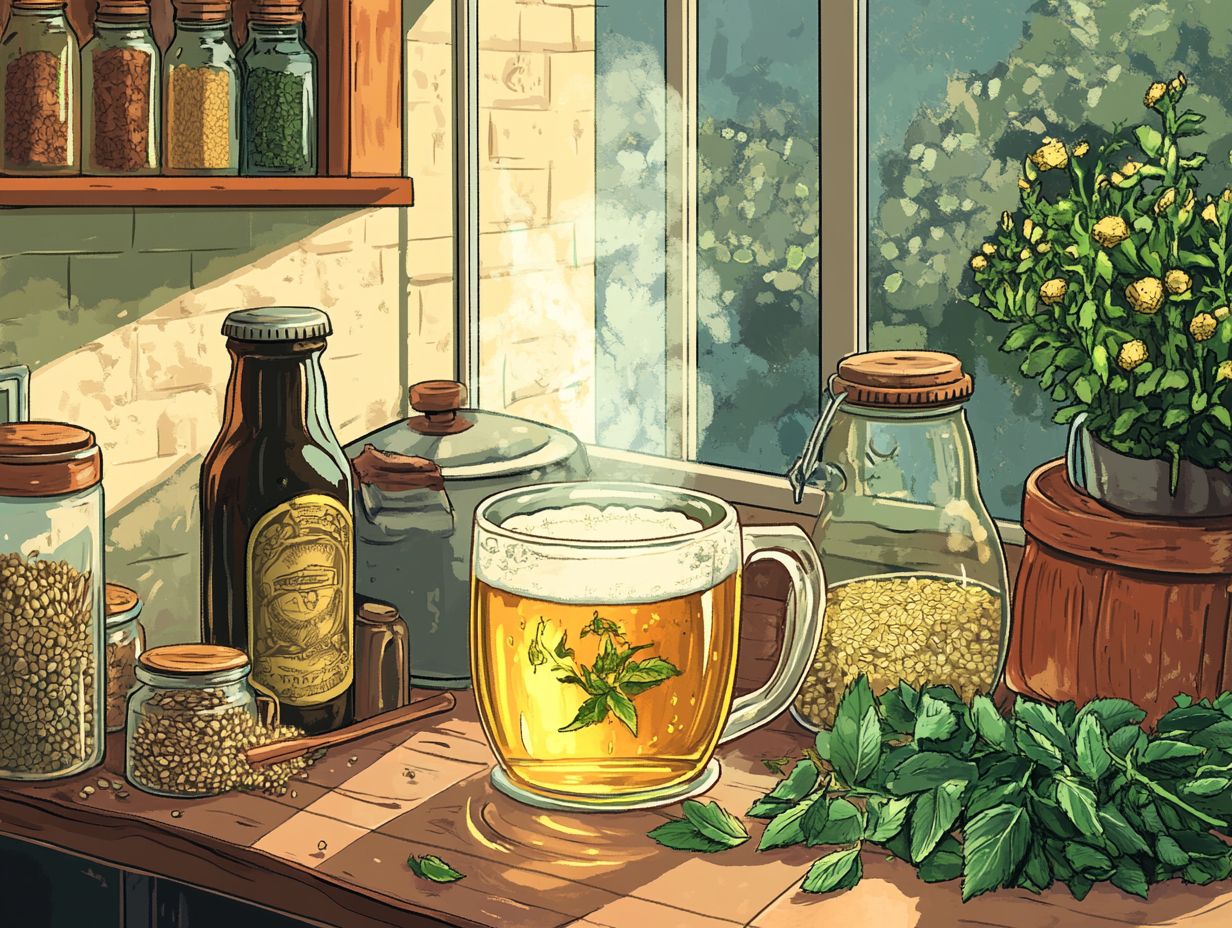
What is herbal infused beer and how is it different from regular beer?
Herbal infused beer is a type of beer brewed with herbs and spices, giving it a unique flavor and aroma. It differs from regular beer because it includes additional ingredients like herbs, fruits, and spices that are not traditionally used in beer brewing.
What are some common herbs used in herbal infused beer?
Some common herbs used in herbal infused beer include chamomile, lavender, rosemary, and ginger. Other popular choices include hibiscus, peppermint, and lemongrass.
Can I use fresh herbs in my herbal infused beer?
Yes, you can use fresh herbs in your herbal infused beer. Fresh herbs can provide a more intense flavor and aroma compared to dried herbs. Just make sure to use the appropriate amount as fresh herbs may be more potent.
How do I add herbs to my beer during the brewing process?
There are a few different methods for adding herbs to your beer during the brewing process. You can add them directly to the boiling wort, create a tea infusion and add it during fermentation, or add them to the secondary fermentation vessel. Experiment with different methods to find the one that works best for you.
Can I use any type of beer to brew an herbal infused beer?
Yes, you can use any type of beer to brew an herbal infused beer. However, some beer styles may work better with certain herbs and spices. For example, a wheat beer may pair well with citrusy herbs like lemon and orange peel, while a stout may be better suited for herbs like coffee or vanilla.
Are there any safety precautions I should take when brewing herbal infused beer?
Yes, there are a few safety precautions to keep in mind when brewing herbal infused beer. Make sure to research the herbs you plan to use and their potential interactions with other ingredients. Also, be cautious of using too much of a certain herb, as it may overpower the flavor of your beer. Lastly, always sanitize your equipment and follow proper brewing techniques to avoid contamination.

